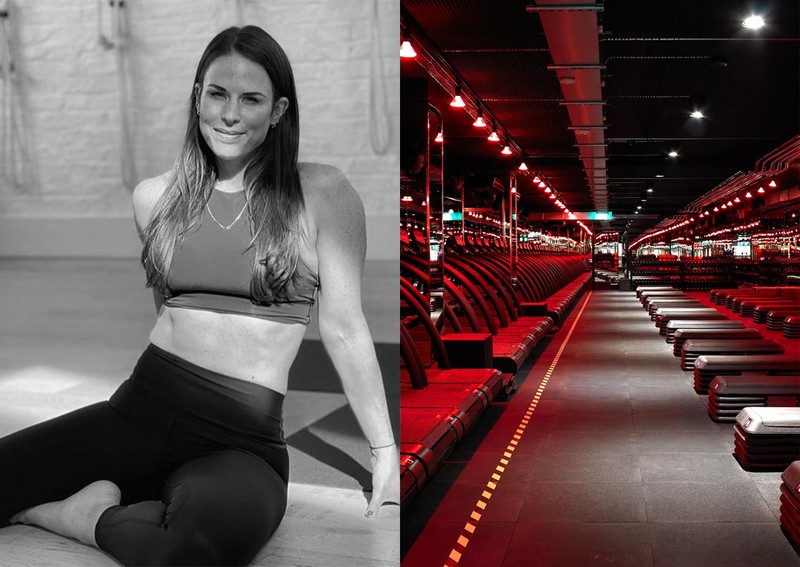A Barry’s Instructor Shares Her Running Rules
Running is the ultimate way to get some headspace. When it comes to feeling mentally and physically strong, it doesn’t get better. And while running in the summer is great, there’s something about being outdoors in winter that feels different. Taking a cluttered mind outdoors and breathing in the crisp air is the best way to clear your head.
I run 20-25 miles per week. I split these sessions into two or three easy-paced sessions and one interval or tempo run. My favourite session of the week is a tempo – or a threshold – run. These are a great way to build stamina and will ultimately help you run faster for longer. The aim is to run 20-30 seconds slower than your 5k race pace, sticking with the same pace for four to seven miles, including a solid warm-up and cool-down either side. If time isn’t on my side, I’ll do three runs per week, each with a different focus to keep the body challenged.
Interval training builds speed. Alternating between sprints and slower paced running works both your aerobic and anaerobic systems to help you become a stronger runner. The key is to recover as hard as you’re running, so don’t scrimp on your active recovery in between sprints. For me, Barry’s is the best place for interval training. Doing intervals on a treadmill makes it easier to track your pace and push yourself to a higher intensity. The Woodway treadmills at Barry’s are designed to work the way the body naturally moves when running outdoors and provide a more reactive run that helps you achieve a more efficient stride.
A warm-up is essential, especially in the colder months. Warming up is important regardless of the season, but it’s imperative in the winter when muscles are colder. Ankle stability is a good place to start – my go-to is an exercise called ‘the alphabet’, which involves tracing the letters of the alphabet with your foot to ensure a full range of movement. Movements that are dynamic or plyometric – like high knees and skipping – are also great to ensure your calves and hip flexors are ready for impact. Don’t forget about your cool-down. A five-minute run at an easy pace followed by a few simple stretches has you covered.
A treadmill workout requires planning. To get the most out of a treadmill run, a warm-up is arguably even more important. Get the body ready for your session by power walking on a slight incline followed by mobility, dynamic stretching and activation exercises, ideally using a small resistance band and a single dumbbell. Fire hydrants and external hip rotation exercises with a mini band are a great way to switch on your glutes, hamstrings and hip flexors ahead of speed work.
I listen to my body to judge how hard I’m working. Using your rate of perceived exertion – or RPE – is a great way to keep tabs on the intensity of your workouts and stay in tune with your body without relying on tech. RPE is a scale of one to ten – one being light activity like a slow stroll, and ten being an all-out sprint you can only maintain for a few seconds. Using RPE as a guide stops you from being too prescriptive in the pace you’re running and gives you a universal language you can use for measuring training or progress. After years of running, I know my body and can easily tune in to how hard I am pushing myself. Personally, running becomes so much more fun and freer when we allow ourselves to relax and feel rather than be overly prescriptive with data.
Not every run needs to be challenging. It’s important to understand all runners have good and bad days. Don’t beat yourself up for a run that hasn’t gone to plan. In my experience, for every good run there will be three or four ‘pavement plods’ to back it up, and that’s okay. It takes the pressure off when we allow 80% of our runs to feel easy, leaving room for the more challenging runs that build resilience.
Cross training will mix things up. As much as I love running, it’s good to keep the body challenged to avoid hitting a plateau with your training. If you are stuck in a running rut, back off your training plan temporarily and focus on other forms of cardio. Swimming, cycling and rowing all work your energy systems in a similar way. Giving your body and mind a break can make all the difference.
I never train on an empty stomach. I’m not into energy gels or chews, although I know plenty of run coaches who swear by them for longer runs. I prefer to get my energy from real foods. I’ll fuel with a hearty snack a couple of hours before a workout and then hydrate with coconut water or a homemade electrolyte drink afterwards. I love Hermosa protein, too – it’s clean, delicious and a great way to top up your protein intake to aid recovery.
Layers are key. The body quickly warms up when running, so don’t overdo it with thick layers. I like tight, breathable lycra that allows me to move freely and better regulate my temperature. My go-to brands for leggings are Vuori, lululemon and Adanola – anything with a high and supportive waistline and a tight-fitting, seamless fabric. When it comes to trainers, I used to be a die-hard Nike Pegasus fan until I discovered Hoka. I alternate between the Bondi SR for outdoor running – the waterproof exterior keeps feet dry and warm – and the Bondi X for treadmill and speed work.
Don’t underestimate rest and recovery. And don’t push yourself too soon – slow and steady wins the race. I see so many people going out too hard, too often, which can quickly lead to both injury and a sense of underachievement. Instead, learn how to get in tune with your body and treat it with kindness, respecting your running by valuing rest and recovery over anything else. Small, sustainable, incremental changes go further than you think when it comes to being a better runner.
For more from Tee follow her on Instagram @TeeVonZee and Barrys.com.
DISCLAIMER: Features published by SheerLuxe are not intended to treat, diagnose, cure or prevent any disease. Always seek the advice of your GP or another qualified healthcare provider for any questions you have regarding a medical condition, and before undertaking any diet, exercise or other health-related programme.
DISCLAIMER: We endeavour to always credit the correct original source of every image we use. If you think a credit may be incorrect, please contact us at info@sheerluxe.com.



